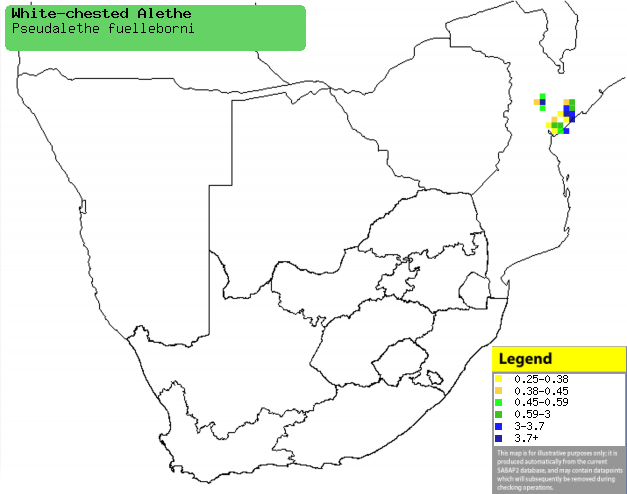|
Pseudalethe fuelleborni (White-chested
alethe, White-breasted alethe)
Witborswoudlyster [Afrikaans];
Witborstalethe [Dutch]; Alèthe à poitrine blanche [French];
Weißbrust-alethe [German]; Pisco-de-peito-branco [Portuguese]
Life
> Eukaryotes >
Opisthokonta
> Metazoa (animals) >
Bilateria >
Deuterostomia > Chordata >
Craniata > Vertebrata (vertebrates) > Gnathostomata (jawed
vertebrates) > Teleostomi (teleost fish) > Osteichthyes (bony fish) > Class:
Sarcopterygii (lobe-finned
fish) > Stegocephalia (terrestrial
vertebrates) > Tetrapoda
(four-legged vertebrates) > Reptiliomorpha > Amniota >
Reptilia (reptiles) >
Romeriida > Diapsida > Archosauromorpha > Archosauria >
Dinosauria
(dinosaurs) > Saurischia > Theropoda (bipedal predatory dinosaurs) >
Coelurosauria > Maniraptora > Aves
(birds) > Order: Passeriformes
> Family: Muscicapidae
For information about this species, see
birdinfo.co.za.
Distribution and habitat
Occurs in the montane forest mountain arc across Tanzania
to eastern Zambia, with a separate population in the understorey of coastal
montane forest in central Mozambique.
|
 |
|
Distribution of White-chested alethe in southern
Africa, based on statistical smoothing of the records from first SA Bird
Atlas Project (©
Animal Demography unit, University of
Cape Town; smoothing by Birgit Erni and Francesca Little). Colours range
from dark blue (most common) through to yellow (least common). |
Food
It mainly eats invertebrates supplemented with fruit,
foraging like a thrush in the leaf litter or gleaning from trunks and branches. The following food items have been recorded
in its diet:
Breeding
- The nest is an open cup of moss along with leaves and old-man's-beard (Usnea)
lichen lined with rootlets. It is typically placed in a tree fork and the
top of a tree stump.
- Egg-laying season is from October-March, peaking from November-December.
- It lays about 3 eggs, which are incubated solely by the female.
- The chicks are brooded by both adults, and are dependent on their
parents for up to 6 weeks after leaving the nest.
Threats
Threatened in central Mozambique, due to habitat
loss from commercial logging, charcoal production and subsistence agriculture.
References
-
Hockey PAR, Dean WRJ and Ryan PG 2005. Roberts
- Birds of southern Africa, VIIth ed. The Trustees of the John Voelcker
Bird Book Fund, Cape Town.
|
